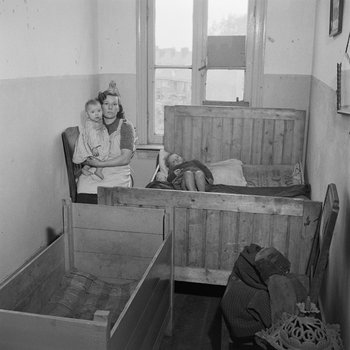Hendrik Peter "Henk" Jonker (Berkhout, 23 November 1912 – Amsterdam, 24 September 2002) was a
Dutch photographer. During World
War II, he documented the impact of
the German occupation of the
Netherlands and after the war he started a
press agency. Praised for portraying "ordinary people and small
moments", his work appeared internationally in publications such as Time and Der Spiegel and was
included in the 1955 exhibition The
Family of Man; particularly notable are his
photographs taken during the North Sea Flood of 1953
Born in Berkhout, a small town in West Friesland, Jonker moved to Amsterdam at the age of 13. During World War II, he had a
job at the Amsterdam office for resident
registration and got involved with the Dutch resistance.
Photographer Marie Östreicher (better known as Maria Austria; the Maria Austria Institute in Amsterdam is named for her) taught him the techniques of photography,
and he was able to forge personal identification documents for the resistance,
until he had to go into hiding in 1944. Tall and blond, on occasion he dyed his
hair black and, disguised as a female nurse,] took photographs of Amsterdam
documenting the German occupation. These photographs were used as documentary
evidence of the occupation, and to strengthen morale and raise funds for
resistance activities. During this period he used the aliases Gerrit Boersma, Frans Kreder, and
Hélène Annie Smitshuisen.
Jonker married Austria after the war was over and for a while was a
full-time photographer. With Austria and others he founded the press agency
Particam (derived from Partizanen Camera) and
documented the post-war reconstruction, as well as the devastation
caused in Zeeland by the North Sea Flood of 1953, which killed over 1800 people in the Netherlands. Jonker arrived in
Zeeland with the very first aid workers, and photographed people standing on
the roofs of their homes. In 1955 one of his photographs was shown in the exhibition The Family of Man, selected
by Edward_Steichen. In 1959 he won second place
in one of the World Press Photo of the
Year categories.
From 1947 to 1950, he lived and worked in Ireland, and from 1963 to 1968,
he worked in Spain during the summers, making patatas fritas, and spent
the winters as a photographer in the Netherlands. In 1968 he settled in Bentveld and worked
for the studios of Harry Pot and George van de Wijngaard. For a while he lived
in Wormerveer and, from 1971 to 1978, in Cruquius, when he worked for the Verenigde
Nederlandse Uitgeverijen, overseeing
set design. In 1982 he moved back to Amsterdam and, after 1986, specialized in
art photography. He also worked for art institutions, such as the Holland Festival, and for
companies, working on calendars, books, and annual reports. His work appeared in Der
Spiegel and Time, and nationally in Margriet and Algemeen Handelsblad.
Jonkers was known for portraying ordinary people and street scenes, and his
photographs of the reconstruction and the 1953 floods are cited as a lasting
legacy. The 1998 exhibition Holland zonder haast ("Holland without haste") was dedicated to him. en.wikipedia
All images © Henk Jonker
























Very cool page!
RispondiElimina